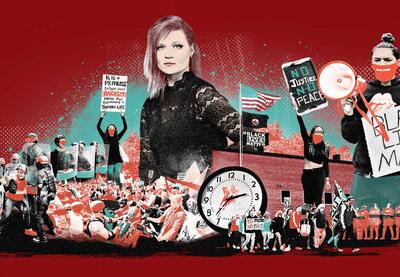In “Every Traveler Has One Vermont Poem,” Audre Lorde succinctly illustrates the pervasiveness of racism in the United States. A peace found in the wonders of nature, where the flowers don’t care that the speaker is “a stranger/making a living choice,” is broken by a young boy shouting the n-word from the seat of his father’s tractor.
For T. Elijah Hawkes, principal at Randolph Union High School in Randolph, Vermont, Lorde’s poem is a lesson in how to recognize his state’s beauty and its troubled history all at once.
“We must dive deeply into an understanding of racism in Vermont, as in every state of the union,” Hawkes says, “because it ruins lives and twists reality and sense of self—of everyone involved. ... We can’t know who we are if we live in denial of who we are and who we’ve been.”
The question of “who we are and who we’ve been” runs deep in Randolph, both at the high school and within the local community. Sounds Like Hate—a new podcast from our colleagues in the Southern Poverty Law Center’s Intelligence Project—dedicates two episodes to that question and to a series of events and controversies that broke the façade of the community’s peaceful setting.
Listen to the episodes!
Listen to "Not Okay," the two-part chapter that explores how one Vermont high school is grappling with whether to fly the Black Lives Matter flag and whether to remove a mascot some say bears a disturbing resemblance to a hooded Klansman.
Back in the early months of 2020, before schools closed due to the coronavirus pandemic, hosts Jamila Paksima and Geraldine Moriba visited Randolph Union High School. In 2018, an increase in racist and xenophobic incidents at the school, which has a 95% white student body, had inspired the creation of a class on racial justice. Student activists decided to push for meaningful change, including symbolic change. As those students advocated for the raising of a Black Lives Matter flag and the removal of a mural they said echoed KKK iconography, others in the community (and beyond it) pushed back.
The story Paksima and Moriba tell offers listeners important lessons for confronting racism in schools, supporting student activism and facilitating critical conversations that reckon with the past. Here are just a few.
Lesson One: Symbols tell a story students notice—and they often reflect systemic problems.
The storylines centered in the podcast revolve around symbols: a Black Lives Matter flag and a mural in the high school gym. The former makes a clear value statement. The latter pits the tradition of a sports mascot against the history it invokes: imagery closely resembling KKK propaganda of the early 20th century.
Both reflect conversations happening nationally about the symbols schools use to show support for Black students and those that undercut that support.
Symbols carry a great deal of meaning and emotional weight. In schools especially, symbols can be cemented by tradition and serve as reflections of identity. The name of a high school appears on diplomas and jerseys across generations. A mascot adorns walls that are backdrops for lifelong memories. But these symbols aren’t stable.
“Their meaning can change over time, sometimes overnight,” Hawkes explains. “And we need to hold ourselves accountable to the shifting meanings and powers, especially negative power.
“If a symbol carries the power of hurt, schools shouldn’t put it on the wall. ... If a child comes to me—as children have come to me—to say that a symbol makes them feel derided or devalued or afraid—I must take this seriously. And if an image makes a person feel whole, seen, valued—one must take that seriously as well. And when it comes time for the deliberations that place tradition on one side of the scale and terror on the other, tradition does not trump terror.”
Nationwide—as protests against racism inspire necessary reflections by all institutions—more schools have reckoned with the harm caused by symbols, such as Confederate-inspired names and statues, or the use of Indigenous mascots. It’s a long overdue recognition. School leaders who do not attend to that harm and the history behind it cannot achieve an equitable learning environment.
Lesson Two: School leaders and educators must embrace discomfort.
Hawkes and other educators who supported the student activists pushing for racial justice in Randolph faced a lot of community backlash. They also had to face their own discomfort in pushing back against the status quo of a community and school they called home.
“Confronting racism can unsettle the order of things,” Hawkes says. “How could it be otherwise? If racism was and is an ordering force of life in this country, then working to dismantle it will shake the order we’ve been accustomed to.”
Hawkes and other educators on the podcast recommend one important way to “unsettle the order of things”: Flatten the typical school power hierarchy. Hawkes talks a lot about the importance of listening at Randolph, be it in restorative justice circles, in advisories, in Socratic seminars or in faculty meetings. Part of that listening is letting students lead, letting students be heard and acting on their recommendations to make their school more inclusive and more enriching for them.
“If we listen well, we’ll be compelled—by the truth of those stories—to take actions that are controversial to some,” Hawkes says. “The discomforts I’ve taken on in making certain decisions are puny when we look at the scale of the violence—interpersonal and structural—that permeates so much of our society and hurts so many.”
That violence often hurts the very students whose well-being may be taking a backseat to their educators’ comfort.
Lesson Three: Supporting student activism is multifaceted work that benefits all students.
Central to the Randolph Union High School story, even today, is the incredible courage of students of color who spoke up in an overwhelmingly white setting. Hawkes says it’s important for school leaders to foster this type of student activism, which can take many forms.
“The supports school leaders provide to students of color needs to be textured and various,” he says. “Students of color will need opportunities to speak and opportunities to be silent; they need leaders and adults who walk in front, to protect and model—and they’ll need chances to be out front themselves, naming the world in their terms.”
Hawkes stresses the value of affinity groups, opportunities for students to talk directly with peers and school faculty about the issues that affect them, and he also encourages spaces where white students and educators are interrogating issues of race.
It’s his hope that these models of listening and learning will benefit all students—including white students—and help them see their roles in pursuing justice. Hawkes says restorative practices have helped students learn about the impact of racism within the school’s specific context, while classes that intentionally focus on social justice issues helped them recognize injustice and consider action.
“Adolescents are ready to declare loyalties to ideas, especially those that indict unfairness or decry injustice,” he explains. “There are white students speaking publicly now about racism in our community who would have been afraid of ostracism by their families for such just a few months before. The courage of their convictions is undergirded by their understanding of the personal stories of their peers and the historical facts.”
Ultimately, Hawkes admits, he hasn’t always gotten it just right. He is a white principal who recognizes the privilege he brings to that position. And ultimately, the story of Randolph Union’s reckoning with racial justice will only have a happy ending when students of color feel safe, valued and liberated in that space.
But Hawkes’ description of Randolph’s restorative circles also charts a path forward for him, for the school and for educators everywhere: It’s about “holding ourselves and others accountable for repairing harm.” That begins and ends with supporting students experiencing that harm—and letting them lead the process toward reparation and transformation.



0 COMMENTS